trailer Peugeot 508 Hybrid 2013 Owner's Manual - RHD (UK, Australia)
[x] Cancel search | Manufacturer: PEUGEOT, Model Year: 2013, Model line: 508 Hybrid, Model: Peugeot 508 Hybrid 2013Pages: 340, PDF Size: 14.59 MB
Page 5 of 340
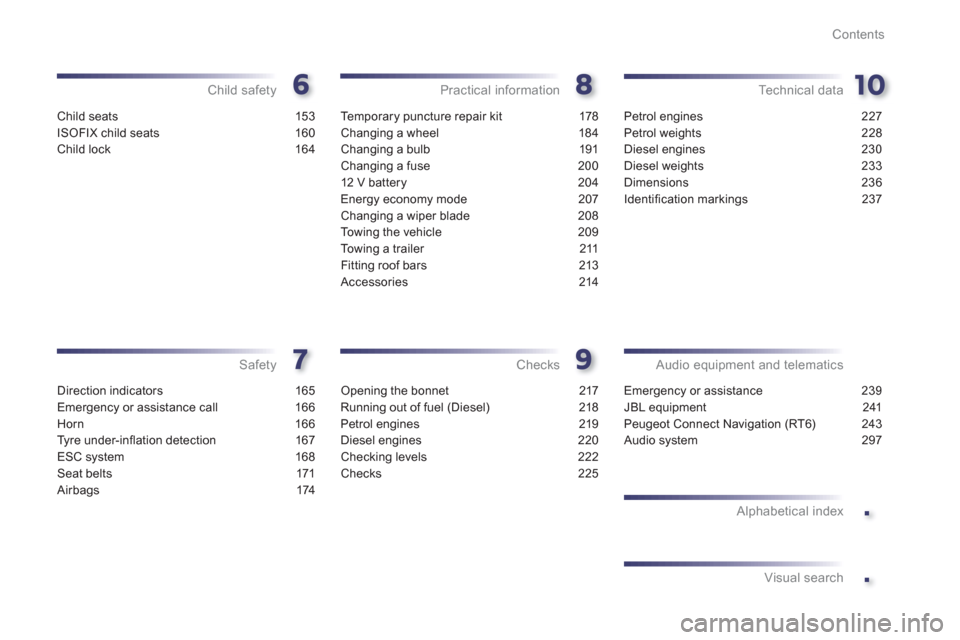
.
.
Contents
Child seats 153
ISOFIX child seats 160
Child lock 164
Child safety
Direction indicators 165
Emergency or assistance call 166
Horn 166
Tyre under-infl ation detection 167
ESC system 168
Seat belts 171
Airbags 174
Safety
Te m p o r a ry puncture repair kit 178
Changing a wheel 184
Changing a bulb 191
Changing a fuse 200
12 V battery 204
Energy economy mode 207
Changing a wiper blade 208
To w i ng the vehicle 209
To w i ng a trailer 211
Fitting roof bars 213
Accessories 214
Practical information
Opening the bonnet 217
Running out of fuel (Diesel) 218
Petrol engines 219
Diesel engines 220
Checking levels 222
Checks 225
Checks
Petrol engines 227
Petrol weights 228
Diesel engines 230
Diesel weights 233
Dimensions 236
Identifi cation markings 237
Technical data
Emergency or assistance 239
JBL equipment 241
Peugeot Connect Navigation (RT6) 243
Audio system 297
Audio equipment and telematics
Alphabetical index
Visual search
Page 23 of 340
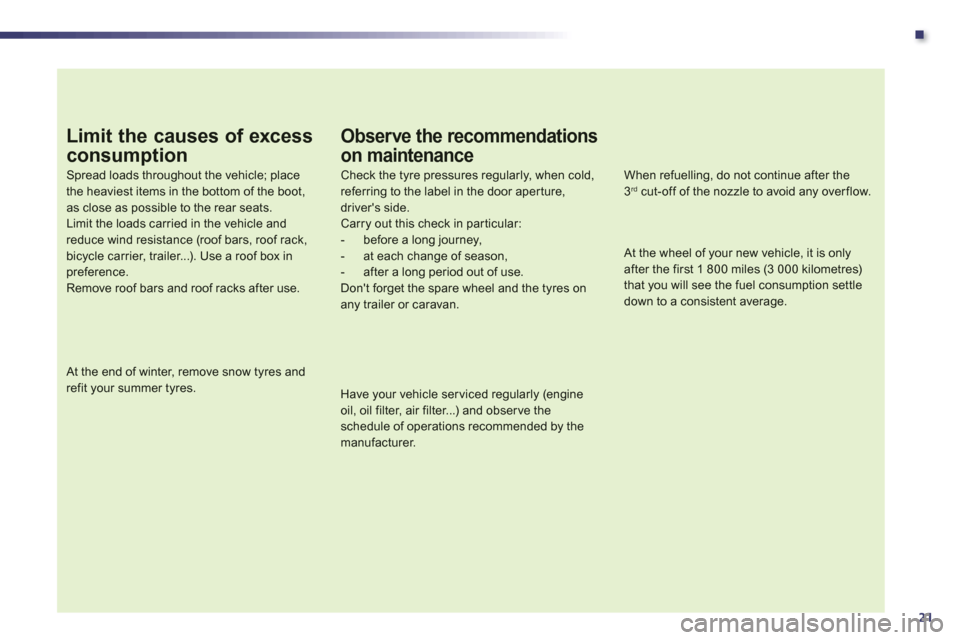
.
21
Limit the causes of excess
consumption
Spread loads throughout the vehicle; placethe heaviest items in the bottom of the boot,as close as possible to the rear seats.Limit the loads carried in the vehicle and reduce wind resistance (roof bars, roof rack, bicycle carrier, trailer...). Use a roof box inpreference.Remove roof bars and roof racks after use.
At the end of winter, remove snow tyres and refit your summer tyres.
Observe the recommendations
on maintenance
Check the tyre pressures regularly, when cold, referring to the label in the door aper ture, driver's side.Carry out this check in par ticular:- before a long journey,- at each change of season,- after a long period out of use. Don't forget the spare wheel and the tyres onany trailer or caravan.
Have your vehicle ser viced regularly (engine oil, oil filter, air filter...) and obser ve the schedule of operations recommended by the
manufacturer.
When refuelling, do not continue after the3 rd
cut-off of the nozzle to avoid any over flow.
At the wheel of your new vehicle, it is only after the first 1 800 miles (3 000 kilometres) that you will see the fuel consumption settledown to a consistent average.
Page 106 of 340
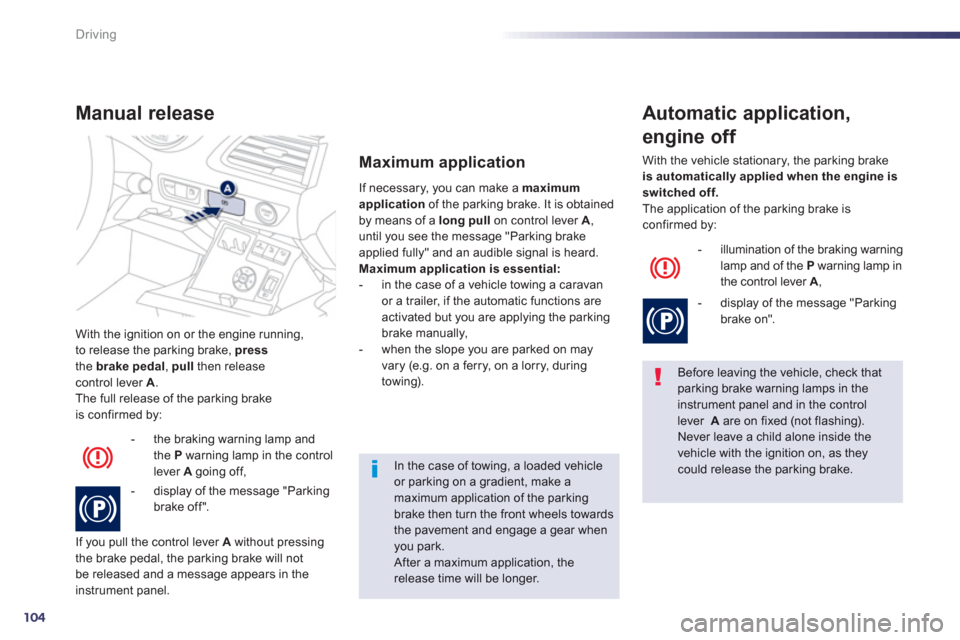
104
Driving
With the ignition on or the engine running,
to release the parking brake, pressthe brakepedal
, pullthen releasecontrol lever A
.
The full release of the parking brake
is confirmed by:
Manual release
- the braking warning lamp and
the P warning lamp in the controllever A
going off,
- displa
y of the message "Parking brake off".
I
f you pull the control lever Awithout pressing
the brake pedal, the parking brake will not
be released and a message appears in the
instrument panel. If necessar
y, you can make a maximum
applicationof the parking brake. It is obtained by means of a long pullon control lever A,
until you see the message "Parking brake
applied fully" and an audible signal is heard.Maximum application is essential:
- in the case of a vehicle towing a caravanor a trailer, if the automatic functions are
activated but you are applying the parkingbrake manually,
- when the slope you are parked on mayvary (e.g. on a ferry, on a lorry, during
towing).
Maximum application
Before leaving the vehicle, check that parking brake warning lamps in the instrument panel and in the control lever A
are on fixed (not flashing).
Never leave a child alone inside thevehicle with the ignition on, as they could release the parking brake.
Automatic application,
engine off
- illumination of the braking warning
lamp and of the Pwarning lamp in
the control lever A ,
- displa
y of the message "Parkingbrake on".
With the vehicle stationary, the parking brake is automatically applied when the engine is
switched off. The application of the parking brake is confirmed by:
In the case of towing, a loaded vehicleor parking on a gradient, make amaximum application of the parkingbrake then turn the front wheels towards the pavement and engage a gear whenyou park.
After a maximum application, the release time will be longer.
Page 135 of 340
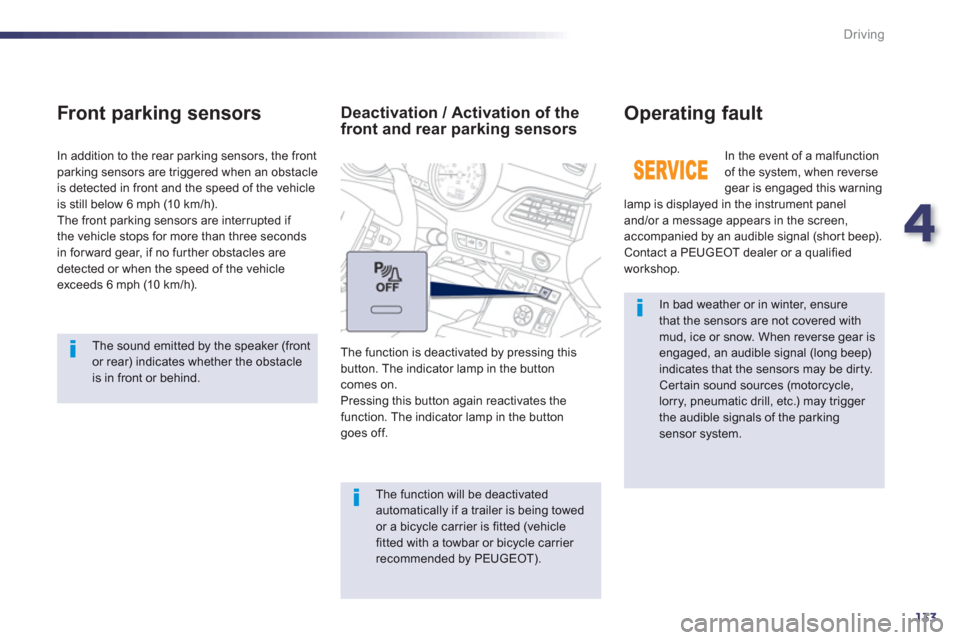
4
133
Driving
In bad weather or in winter, ensure that the sensors are not covered with mud, ice or snow. When reverse gear isengaged, an audible signal (long beep)indicates that the sensors may be dirty.
Cer tain sound sources (motorcycle, lorry, pneumatic drill, etc.) may trigger the audible signals of the parkingsensor system. In th
e event of a malfunction
of the system, when reversegear is engaged this warning
lamp is displayed in the instrument panel
and/or a message appears in the screen,
accompanied by an audible signal (short beep).
Contact a PEUGEOT dealer or a qualified
wor
kshop.
Operating fault
In addition to the rear parking sensors, the front
parking sensors are triggered when an obstacle
is detected in front and the speed of the vehicle
is still below 6 mph
(10 km/h).
The front parking sensors are interrupted if
the vehicle stops for more than three seconds
in
forward gear, if no fur ther obstacles are
detected or when the speed of the vehicle exceeds 6 mph (10 km/h).
Front par king sensors
The function will be deactivated automatically if a trailer is being towedor a bicycle carrier is fitted (vehicle fitted with a towbar or bicycle carrier recommended by PEUGEOT).
Deactivation / Activation of thefront and rear parking sensors
The function is deactivated by pressing this
button. The indicator lamp in the button
comes on.Pressing this button again reactivates thefunction. The indicator lamp in the button
goes off.
The sound emitted by the speaker (frontor rear) indicates whether the obstacle is in front or behind.
Page 204 of 340
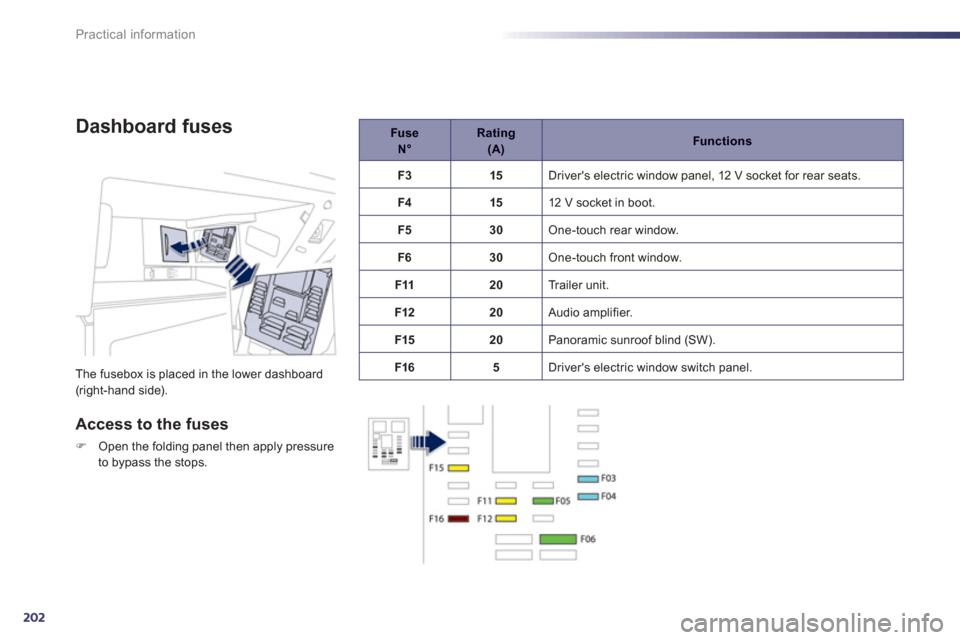
202
Practical information
Dashboard fuses
The fusebox is placed in the lower dashboard (right-hand side).
Access to the fuses
FOpen the folding panel then apply pressure
to bypass the stops.
Fuse N°Rating (A)Functions
F
315 Driver's electric window panel, 12 V socket for rear seats.
F415
12 V socket in boot.
F5
30 One-touch rear window.
F
630 One-touch front window.
F1
120
Trailer unit.
F1220
Audio amplifier.
F1
520
Panoramic sunroof blind (SW).
F1
65
Driver's electric window switch panel.
Page 213 of 340
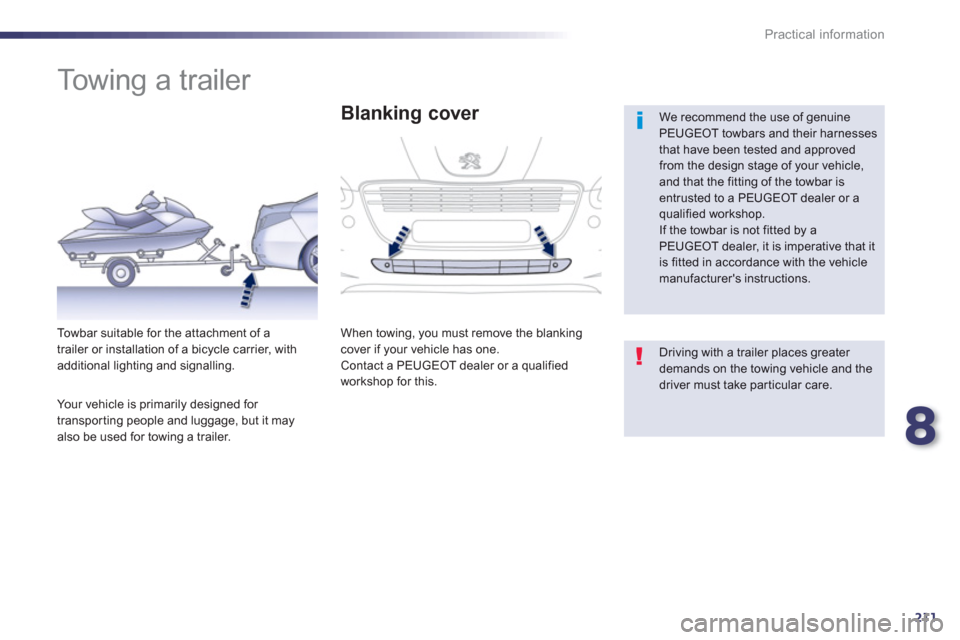
8
211
Practical information
Towing a trailer
We recommend the use of genuine PEUGEOT towbars and their harnesses that have been tested and approvedfrom the design stage of your vehicle, and that the fitting of the towbar isentrusted to a PEUGEOT dealer or aqualified workshop.
If the towbar is not fitted by a PEUGEOT dealer, it is imperative that itis fitted in accordance with the vehicle manufacturer's instructions.
T
owbar suitable for the attachment of atrailer or installation of a bicycle carrier, with
additional lighting and signalling.
Blanking cover
When towing, you must remove the blanking cover if your vehicle has one.
Contact a PEUGEOT dealer or a qualified
workshop for this.
Driving with a trailer places greater demands on the towing vehicle and the driver must take par ticular care.
Your vehicle is primaril
y designed for
transporting people and luggage, but it mayalso be used for towing a trailer.
Page 214 of 340
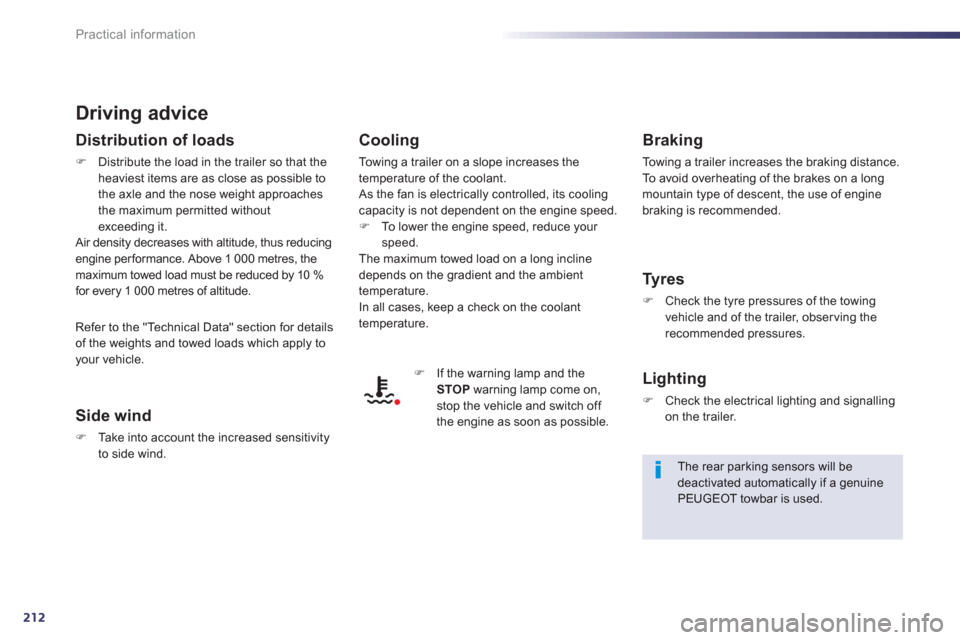
212
Practical information
Driving advice
Distribution of loads
FDistribute the load in the trailer so that theheaviest items are as close as possible to
the axle and the nose weight approaches
the maximum permitted without
excee
ding it.
Air density decreases with altitude, thus reducingengine performance. Above 1 000 metres, the maximum towed load must be reduced by 10 %
for every 1 000 metres of altitude.
Side wind
FTake into account the increased sensitivity
to side wind.
Cooling
To w i ng a trailer on a slope increases the
temperature of the coolant.
As the fan is electricall
y controlled, its cooling capacity is not dependent on the engine speed.
F
To lower the engine speed, reduce your speed.
The maximum towed load on a long incline
depends on the
gradient and the ambient
temperature.
In all cases, keep a check on the coolant
temperature.
FIf the warning lamp and the
STOP warning lamp come on, stop the vehicle and switch off
the engine as soon as possible.
Braking
To w i ng a trailer increases the braking distance.
To avoid overheating of the brakes on a longmountain type of descent, the use of engine braking is recommended.
Tyres
F
Check the tyre pressures of the towingvehicle and of the trailer, obser ving the recommended pressures.
Lighting
F
Check the electrical lighting and signalling on the trailer.
The rear parking sensors will be deactivated automatically if a genuine PEUGEOT towbar is used.
R
efer to the "Technical Data" section for details
of the weights and towed loads which apply to your vehicle.
Page 216 of 340
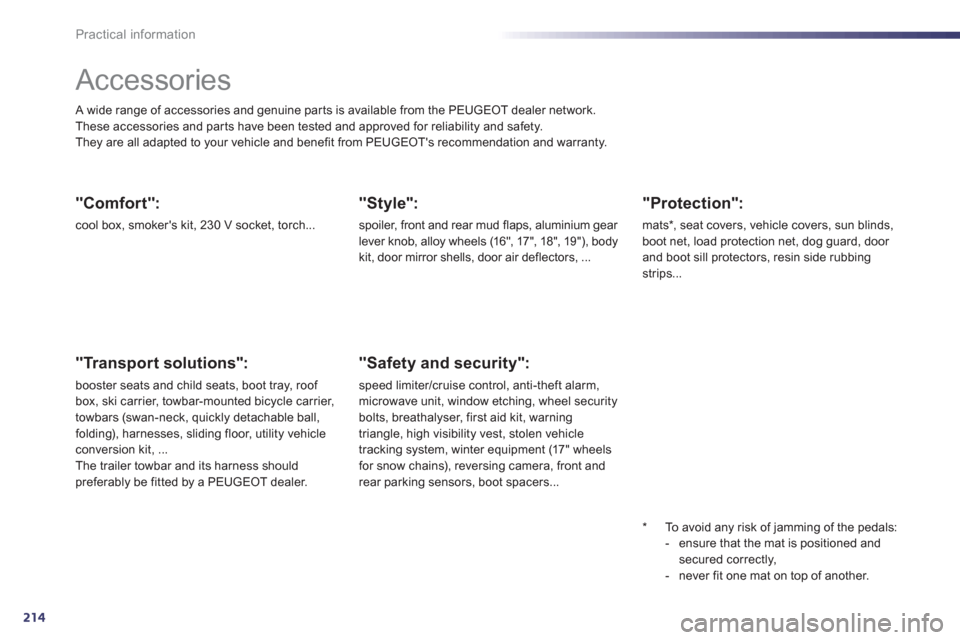
214
Practical information
Accessories
A wide range of accessories and genuine par ts is available from the PEUGEOT dealer network.
These accessories and par ts have been tested and approved for reliability and safety.
They are all adapted to your vehicle and benefit from PEUGEOT's recommendation and warranty.
"Comfort":
cool box, smoker's kit, 230 V socket, torch...
"Transport solutions":
booster seats and child seats, boot tray, roof
box, ski carrier, towbar-mounted bicycle carrier,
towbars (swan-neck, quickly detachable ball, folding), harnesses, sliding floor, utility vehicleconversion kit, ...
The trailer towbar and its harness shouldpreferably be fitted by a PEUGEOT dealer.
"Style":
spoiler, front and rear mud flaps, aluminium gear lever knob, alloy wheels (16 ", 17 ", 18 ", 19 "), body kit, door mirror shells, door air deflectors, ...
*
To avoid an
y risk of jamming of the pedals:
- ensure that the mat is positioned and
secured correctl
y,
- never fit one mat on top of another.
"Safety and security":
speed limiter/cruise control, anti-theft alarm,
microwave unit, window etching, wheel securitybolts, breathalyser, first aid kit, warningtriangle, high visibility vest, stolen vehicle
tracking system, winter equipment (17" wheels for snow chains), reversing camera, front andrear parking sensors, boot spacers...
"Protection":
mats *
, seat covers, vehicle covers, sun blinds,boot net, load protection net, dog guard, door
and boot sill protectors, resin side rubbingstrips...
Page 230 of 340
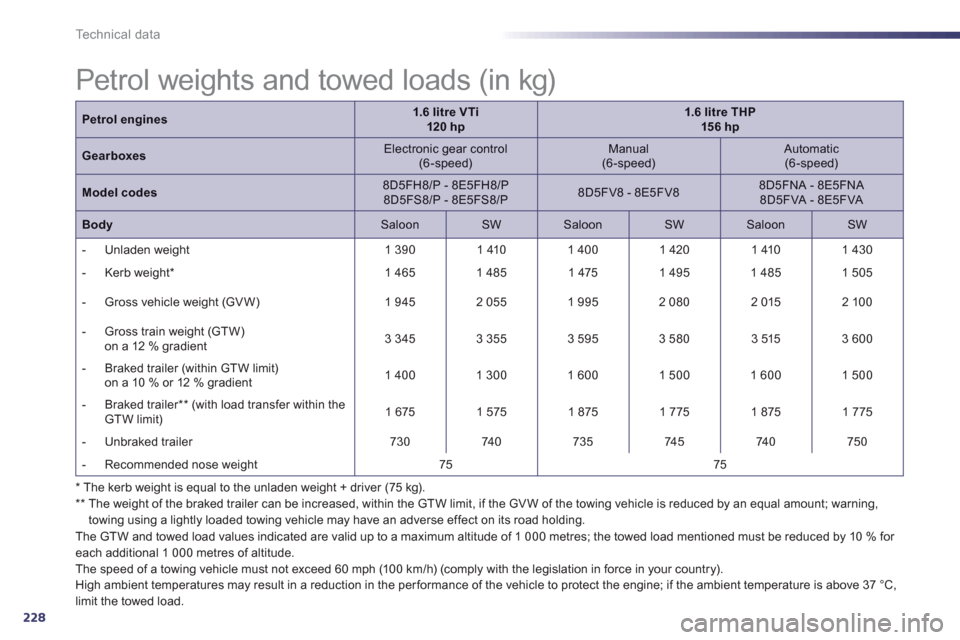
228
Technical data
*
The kerb weight is equal to the unladen weight + driver (75 kg). **
The weight of the braked trailer can be increased, within the GTW limit, if the GVW of the towing vehicle is reduced by an equal amount; warning,
towing using a lightly loaded towing vehicle may have an adverse effect on its road holding.
Petrol weights and towed loads (in kg)
The GTW and towed load values indicated are valid up to a maximum altitude of 1 000 metres; the towed load mentioned must be reduced by 10 % for each additional 1 000 metres of altitude.
The speed of a towing vehicle must not exceed 60 mph (10 0 km/h) (comply with the legislation in force in your country).
High ambient temperatures may result in a reduction in the performance of the vehicle to protect the engine; if the ambient temperature is above 37 °C,
limit the towed load.
Petrol engines1.6 litre V Ti120 hp1.6 litre THP156 hp
GearboxesElectronic gear control(6-speed)
Manual(6-speed)
Automatic(6-speed)
Model codes
8D5FH8/P - 8E5FH8/P 8D5FS8/P - 8E5FS8/P 8D5FV8 - 8E5FV8
8D5FNA - 8E5FNA 8D5FVA - 8E5FVA
BodySaloon
SW
Saloon SW
Saloon
SW
- Unladen wei
ght 1 390
1 410
1 400
1 420
1 410
1 430
- Kerb weight *
1 465 1 485
1 475 1 495
1 485
1 505
- Gross vehicle wei
ght (GV W)
1 945 2 0551 9952 080
2 015 2 10 0
- Gross train weight (GTW)
on a 12 % gradient 3 3453 355
3 595
3 5803 515
3 600
- Braked trailer
(within GTW limit) on a 10 % or 12 % gradient1 400
1 3001 6001 500
1 600
1 500
- Braked trailer ** (with load transfer within the
GTW limit) 1 675 1 575 1 875 1 7751 875 1 775
-
Unbraked trailer
730
740735
745
740
750
- Recommended nose weight 7575
Page 231 of 340
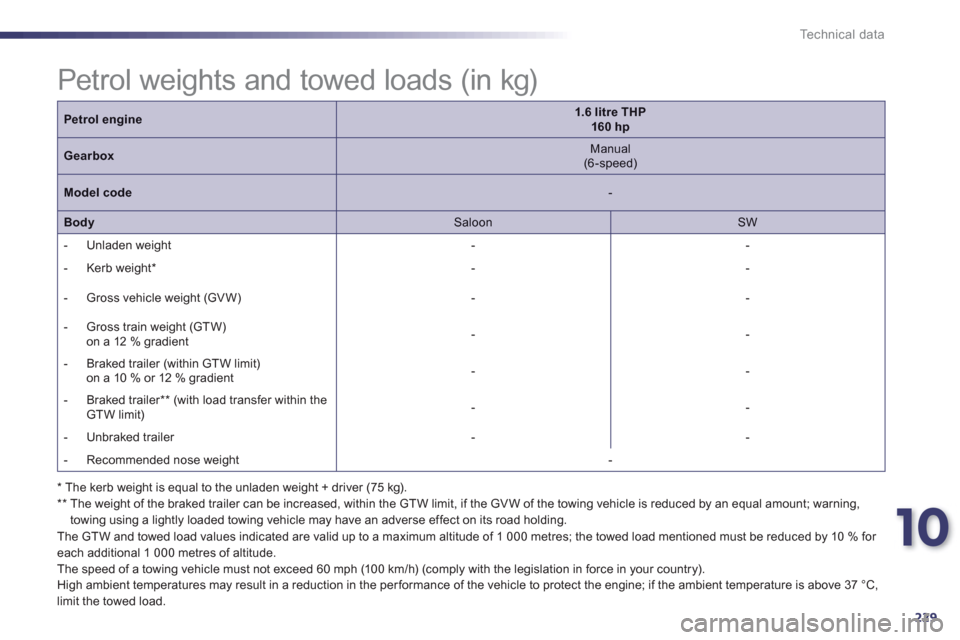
10
229
Technical data
Petrol engine1.6 litre THP 160 hp
Gearbox
Manual(6-speed)
Model code
-
Body
Saloon
SW
- Unladen wei
ght -
-
- Kerb weight
*-
-
- Gross vehicle wei
ght (GV W)
-
-
-
Gross train weight (GTW)
on a 12 % gradient --
- Braked trailer (within GTW limit) on a 10 % or 12 % gradient--
- Braked trailer ** (with load transfer within the
GTW limit) -
-
-
Unbraked trailer --
- Recommended nose weight
-
*
The kerb weight is equal to the unladen weight + driver (75 kg). **
The weight of the braked trailer can be increased, within the GTW limit, if the GVW of the towing vehicle is reduced by an equal amount; warning,
towing using a lightly loaded towing vehicle may have an adverse effect on its road holding.
Petrol weights and towed loads (in kg)
The GTW and towed load values indicated are valid up to a maximum altitude of 1 000 metres; the towed load mentioned must be reduced by 10 % for each additional 1 000 metres of altitude.
The speed of a towing vehicle must not exceed 60 mph (10 0 km/h) (comply with the legislation in force in your country).
High ambient temperatures may result in a reduction in the performance of the vehicle to protect the engine; if the ambient temperature is above 37 °C,
limit the towed load.